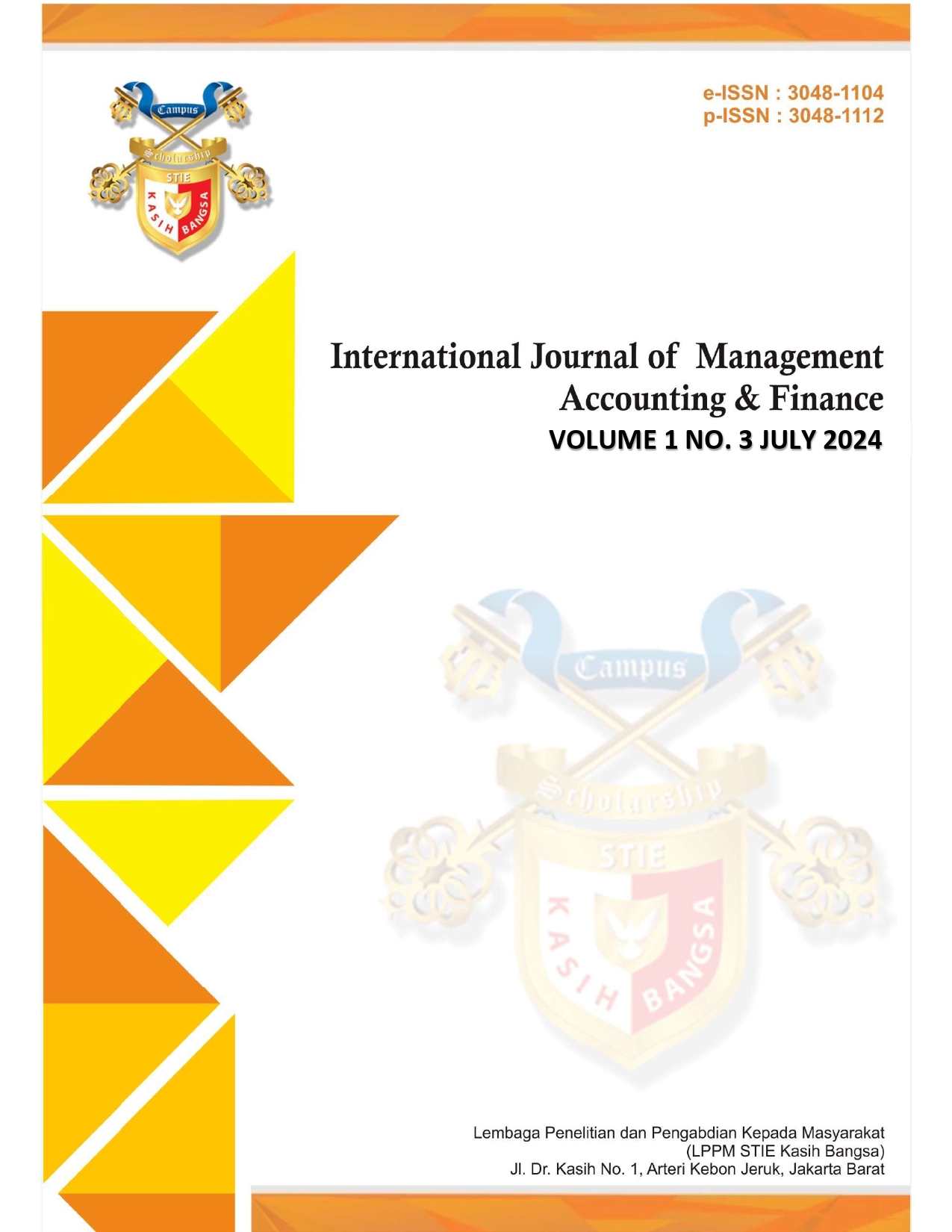Liquidity Shocks and Corporate Resilience: Exploring the Interplay of Trade Credit and Bank Financing in Firm Performance
DOI:
https://doi.org/10.70142/kbijmaf.v1i4.237Keywords:
Liquidity Shocks, Corporate Resilience, Trade Credit, Bank Financing, Firm PerformanceAbstract
This qualitative literature review investigates the interplay between liquidity shocks and corporate resilience, focusing on the roles of trade credit and bank financing in firm performance. The review synthesizes existing research to elucidate how firms navigate liquidity constraints during economic turbulence, emphasizing the critical importance of strategic financial management. The findings reveal that liquidity shocks often compel firms to adopt conservative financial practices, which can limit their growth potential. However, effective utilization of trade credit serves as a vital buffer, allowing firms to maintain operational flexibility and mitigate risks associated with funding constraints. Furthermore, the review underscores the necessity for firms to employ diversified financing strategies that integrate trade credit and bank loans to enhance resilience and long-term performance. The study also highlights the evolving landscape of financial technology, which presents new opportunities for improving access to credit and supporting corporate sustainability. This review provides a foundation for future research into the complex dynamics of liquidity, trade credit, and bank financing, offering valuable insights for practitioners and policymakers alike.
References
Agarwal, S., Qian, W., Ren, Y., Tsai, H. T. T., & Yeung, B. Y. (2020). The real impact of FinTech: Evidence from mobile payment technology. Available at SSRN 3556340.
Almeida, H., & Campello, M. (2007). Financial constraints, asset tangibility, and corporate investment. Review of Financial Studies, 20(4), 1429–1460.
https://doi.org/10.1093/rfs/hhm008
Almeida, H., Campello, M., Laranjeira, B., & Weisbenner, S. (2012). Corporate debt maturity and the real effects of the 2007 credit crisis. Critical Finance Review, 1(1), 3–58. https://doi.org/10.1561/104.00000001
Almeida, H., Carvalho, D., & Kim, T. (2024). The Working Capital Credit Multiplier. The Journal of Finance. First published: 27 August 2024. https://doi.org/10.1111/jofi.13385
Amberg, N., Jacobson, T., von Schedvin, E., & Townsend, R. (2021). Curbing shocks to corporate liquidity: The role of trade credit. Journal of Political Economy, 129(1), 182–242. https://doi.org/10.1086/711211
Bai, J., Carvalho, D., & Phillips, G. (2018). The impact of bank credit on labor reallocation and aggregate industry productivity. Journal of Finance, 73(6), 2787–2836. https://doi.org/10.1111/jofi.12683
Barrot, J.-N. (2016). Trade credit and industry dynamics: Evidence from trucking firms. Journal of Finance, 71(4), 1975–2016. https://doi.org/10.1111/jofi.12423
Bernanke, B., Gertler, M., & Gilchrist, S. (1999). The financial accelerator in a quantitative business cycle framework. In J. Taylor & M. Woodford (Eds.), Handbook of Macroeconomics (pp. 1341–1393). Elsevier Science.
Chodorow-Reich, G. (2014). The employment effects of credit market disruptions: Firm-level evidence from the 2008–09 financial crisis. Quarterly Journal of Economics, 129(1), 1–59. https://doi.org/10.1093/qje/qjt014
Costello, A. M. (2020). Credit market disruptions and liquidity spillover effects in the supply chain. Journal of Political Economy, 128(10), 3434–3468.
https://doi.org/10.1086/709643
Cunat, V. (2007). Trade credit: Suppliers as debt collectors and insurance providers. Review of Financial Studies, 20(2), 491–527. https://doi.org/10.1093/rfs/hhm022
Fazzari, S. M., Hubbard, R. G., & Petersen, B. C. (1988). Financing constraints and corporate investment. Brookings Papers on Economic Activity, 1988(1), 1141–1195.
Froot, K. A., Scharfstein, D. S., & Stein, J. C. (1990). Risk management: Coordinating corporate investment and financing policies. Journal of Finance, 45(4), 1629–1658. https://doi.org/10.1111/j.1540-6261.1990.tb03991.x
Gan, J. (2007). The real effects of asset market bubbles: Loan- and firm-level evidence of a lending channel. Review of Financial Studies, 20(6), 1941–1973.
Gertler, M., & Gilchrist, S. (2018). What happened: Financial factors in the great recession. Journal of Economic Perspectives, 32(3), 3–30.
Giannetti, M., Burkart, M., & Ellingsen, T. (2011). What you sell is what you lend? Explaining trade credit contracts. Review of Financial Studies, 24(4), 1261–1298.
https://doi.org/10.1093/rfs/hhq116
Heitor, A., Carvalho, D., & Kim, T. (2024). The Working Capital Credit Multiplier. The Journal of Finance. First published: 27 August 2024. https://doi.org/10.1111/jofi.13385
Higgins, J. P. T., Thomas, J., Chandler, J., Cumpston, M., Li, T., Page, M. J., & Welch, V. A. (2019). Cochrane Handbook for Systematic Reviews of Interventions (2nd ed.). Wiley.
Hunt, H. S., Elmore, R., & Johnston, D. (2017). Publication bias in academic research: A literature review and recommendations. Journal of Research Practice, 13(1), 1–18. https://doi.org/10.26739/2572-4045-1-2
Lian, S., & Ma, J. (2021). Trade credit, bank credit, and firm performance in the digital economy: Evidence from China. The Journal of Technology Transfer.
https://doi.org/10.1007/s10961-021-09820-8
Mendoza, E. G. (2010). Sudden stops, financial crises, and leverage. American Economic Review, 100(5), 1941–1966.
Paravisini, D., Rappoport, V., Schnabl, P., & Wolfenzon, D. (2015). Dissecting the effect of credit supply on trade: Evidence from matched credit-export data. Review of Economic Studies, 82(1), 333–359.
Petersen, M. A., & Rajan, R. G. (1997). Trade credit: Theories and evidence. The Review of Financial Studies, 10(3), 661–691. https://doi.org/10.1093/rfs/10.3.661
Tranfield, D., Denyer, D., & Smart, P. (2003). Towards a methodology for developing evidence-informed management knowledge by means of systematic review. British Journal of Management, 14(3), 207–222. https://doi.org/10.1111/1467-8551.00375
Whelan, E. (2019). An analysis of the quality of systematic reviews in the field of management. International Journal of Management Reviews, 21(3), 470–487.
https://doi.org/10.1111/ijmr.12187
Wilner, B. S. (2000). The exploitation of relationships in financial distress: The case of trade credit. Journal of Finance, 55(1), 153–178.
Wohlin, C. (2014). Guidelines for snowballing in systematic literature studies and a replication in software engineering. Proceedings of the 18th International Conference on Evaluation and Assessment in Software Engineering.
















